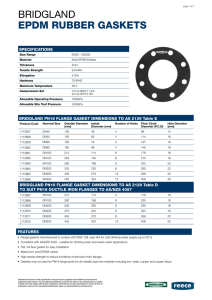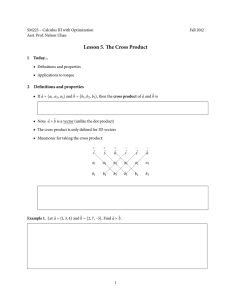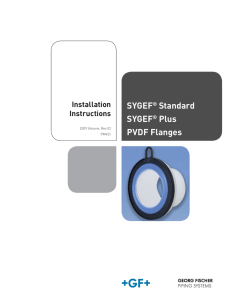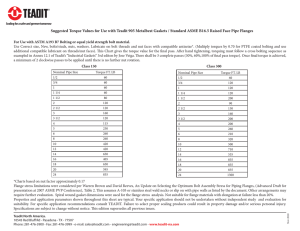Non-Metallic Piping Expansion Joint Installation Procedures
advertisement
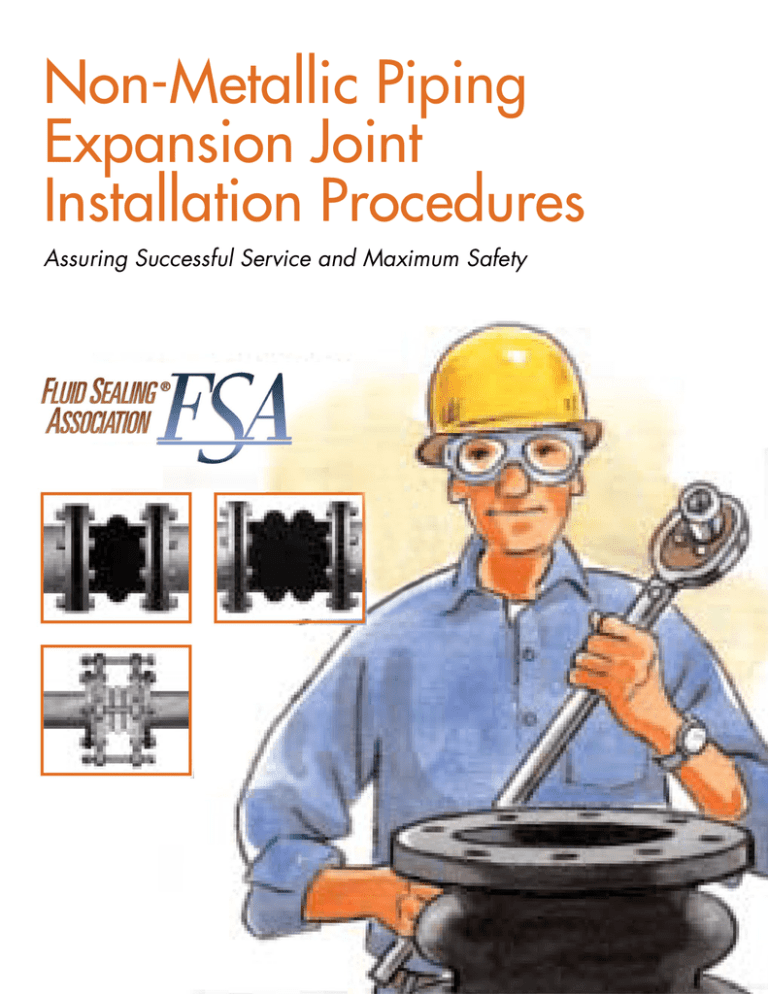
Non-Metallic Piping Expansion Joint Installation Procedures Assuring Successful Service and Maximum Safety A Guide to Effective Installation of NonMetallic Expansion Joints Effective operation of non-metallic expansion joints depends on proper installation of all components of a well-designed piping system. This document provides guidance to maintenance operators and engineers to ensure the installation of an expansion joint meets or exceeds system requirements. It is intended to complement other plant-approved installation procedures. NOTE: This guide presents typical NonMetallic expansion joint installations. Contact manufacturer for specific details. Tools Required Specific tools are required for installation of expansion joints. Additionally, always use standard safety equipment and follow good safety practices. Acquire the following equipment prior to installation: • Calibrated torque wrench • Tape measure • Lubricant for elastomer flanges • Appropriate safety equipment • Carpenter square • Other plant specified equipment 1 Review, Examine and clean Confirm system operating requirements: pressure/vacuum, temperature, vibration, and movements. Review anchors, supports, and alignment guides to assure they meet system requirements: • Assure anchors and guides can withstand expansion joint pressure thrusts and spring rates. • Add control units and compression sleeves when piping is not properly anchored. Examine expansion joint including exterior, interior, and flange faces for cuts and gouges. Examine pipe flange faces for roughness and damage. Remove all foreign material and debris. Replace any components found to be defective. If in doubt, contact manufacturer. 2 Align flanges Position pipe flange faces to ensure axes are aligned to within 1/8 inch without using excessive force. Use of an offset joint may be required when piping does not align properly. Consult manufacturer. 3 Install expansion joint Copyright © 2015 No duplication without the written consent of the Fluid Sealing Association or European Sealing Association. ISBN 1-892965-20-8 Assure expansion joint matches the specified size, material, and capabilities for the application. If required, apply a thin layer of non-petroleum based lubricant, such as soapy water to the flanges. Carefully install the expansion joint to assure no damage occurs, and align bolt holes. Support the expansion joint until bolted in place. Spacer gaskets may be required with raised face pipe flanges, consult manufacturer. 4 Install and tighten bolts visible bulge Step 1 – Insert bolts with washers through retaining rings on the arched side of the expansion joint and then through to the mating flanges in a cross pattern. (Where there is not enough room for a bolt, fully threaded rod can be used with nut on each end. All thread past the nut on arched side should be kept to a minimum.) Step 2 – Attach and tighten nuts (with washers) until hand tight. Step 3 – Torque each bolt to full torque with the cross-bolt pattern until the outside edge of the expansion joint flange bulges slightly. When control units are required install gusset plates on the outboard side of the mating flange. Insert rods through the outside hole in the plate. Note: The number and distribution of control rods must meet manufacturer approved or design specified minimums. FSA Technical Handbook minimums shall apply if not specified otherwise. When required, install a compression sleeve while the control rod is inserted into the gusset plate. Place the nuts and the metal and/or elastomer washers on the control rods. Lock the nuts at the locations specified by the manufacturer. 5b 5a Bolt torque - Bolt torque - Joints with beaded-ends (spherical designs) or PTFE Bellows type Joints with full-faced elastomer flanges Tighten bolts in two to three successive steps with a cross-bolt tightening pattern to the nominal torque shown on the table below. Tighten bolts so expansion joint flange outside edge bulges slightly between the retaining rings and the mating flange to assure leak-free operation. Periodically NOMINAL BOLT TORQUE re-torque Full-Faced Elastomer Flanges bolts after Pipe Size Torque system in mm ft-lbs Nm start-up. Use visible flange edge bulge to gauge. 6 1-2 2.5-5 6-8 10-12 14-16 18-24 26-40 42-54 60-72 25-50 60-125 150-200 250-300 350-400 450-600 650-1000 1050-1400 1500-1800 30-50 50-70 90-120 110-140 130-160 150-200 200-300 300-400 400-500 40-68 68-95 120-160 150-160 175-215 200-270 270-410 410-540 540-680 Tighten bolts in two to three successive steps with a cross-bolt tightening pattern to the nominal torque shown on the table below to assure leak-free operation. Note: Never tighten to the point of metal-to-metal contact between the joint and mating flanges. Over-tightening can cause deformation of the expansion joint sealing bead and premature failure. Periodically re-torque bolts after system start-up. FSA or any constituent members make no guarantee as to the accuracy, relevancy, appropriateness, currency or completeness of the data and information contained herein. It is solely provided “as is.” Further, FSA and constituent members exclude all direct, indirect, incidental, consequential or punitive damages, whether foreseeable or not, and whether they were known or not. NOMINAL BOLT TORQUE Beaded-Ends (Spherical) or PTFE Bellows Pipe Size Torque in 1-1.25 1.5-2 2.5 3-5 6-8 10-12 14-16 18 20 24 30 mm 25-32 40-50 65 80-125 150-200 250-300 350-400 450 500 600 750 ft-lbs 30-45 30-45 35-50 45-60 50-65 55-75 60-80 70-90 75-95 80-100 95-130 Nm 40-60 40-60 47-68 60-80 68-88 75-100 80-110 95-120 95-120 110-175 120-175 Note 1: Recommended Torque values are for reference only and may require more or less torque due to flange facing, and other variables. Caution: Mating flange material or equipment may dictate lower torque values. Consult the Manufacturer for specific recommendations. Note 2: The Flange Bolts should be re-tightened after about one week of operation and checked periodically, thereafter. Maintenance and storage Inspect the expansion joint periodically to confirm satisfactory installation and operation and remove any debris on and around the expansion joint. Periodically re-torque bolts. Apply plant-approved maintenance procedures as required. When welding near the expansion joint, cover with a blanket or other protective device to prevent damage. Storage: Expansion joints should be stored in a relatively dry, dark, cool warehouse location. Storage near ozone producing equipment should be avoided. Store flange face down evenly supported on a pallet or wooden platform. Do not store other heavy items on top of an expansion joint. A minimum five-year shelf-life may be expected with ideal conditions. If storage must be outdoors, the expansion joint should be placed on a wooden platform above possible water line and covered with a tarpaulin. It should not be in contact with the ground. For further details on piping expansion joint installation, please refer to the FSA Technical Handbook – Non-Metallic Expansion Joints and Flexible Pipe Connectors available from the Fluid Sealing Association. Fluid Sealing Association 994 Old Eagle School Road – Suite 1019 Wayne, PA 19087-1802, United States of America Phone: 610-971-4850 • Fax: 610-971-4859 www.fluidsealing.com European Sealing Association European Sealing Association 310, Route de la Plagne Morzine, France 74110 Tel: +33 (0) 631 941 600 www.europeansealing.com This document has been presented by:
